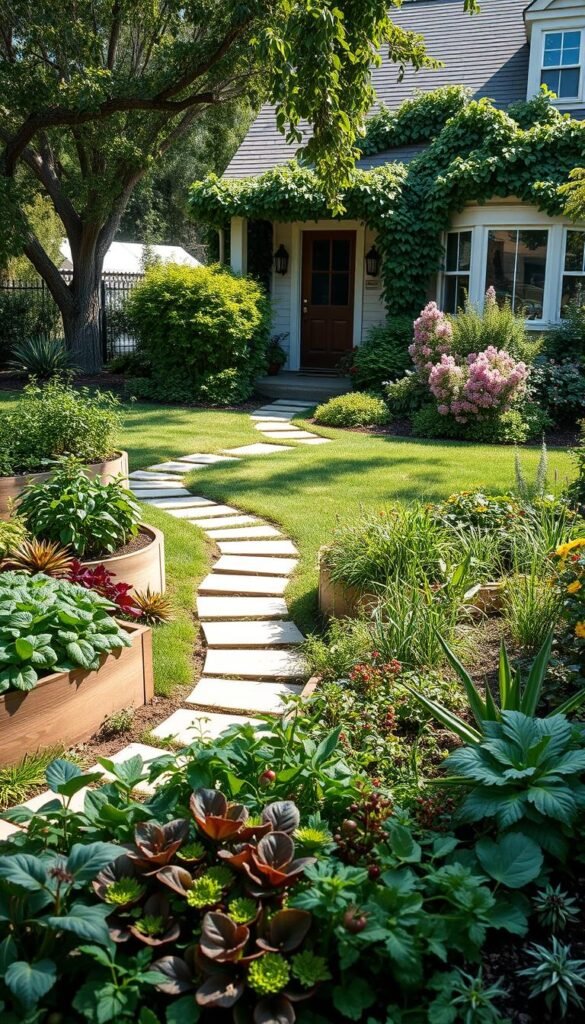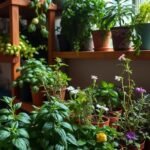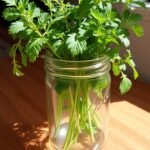Imagine stepping outside your door to pluck fresh herbs or juicy tomatoes while enhancing your home’s visual charm. Combining food plants with decorative landscaping isn’t just practical—it’s a smart way to maximize your outdoor space. As Ivette Soler notes in The Edible Front Yard, this approach requires plants that shine in looks and productivity.
Your most visible outdoor area deserves extra attention. Unlike backyard plots, these spaces need to impress neighbors and passersby year-round. Think colorful kale paired with flowering perennials or strawberry plants edging a walkway. Every choice reflects your personal style and values.
Strategic design ensures your edible landscape thrives without sacrificing curb appeal. Focus on varieties that offer seasonal interest, like artichokes with silvery leaves or blueberries with fiery fall foliage. Mix textures and heights to create depth, using herbs as fragrant groundcovers or trellised beans as living screens.
This isn’t just gardening—it’s a statement about sustainable living. By blending food plants into your landscape, you’ll enjoy fresh flavors while boosting property value. Ready to transform that grassy strip into something deliciously beautiful? Let’s explore how to make it work.
Understanding the Benefits of an Edible Front Yard
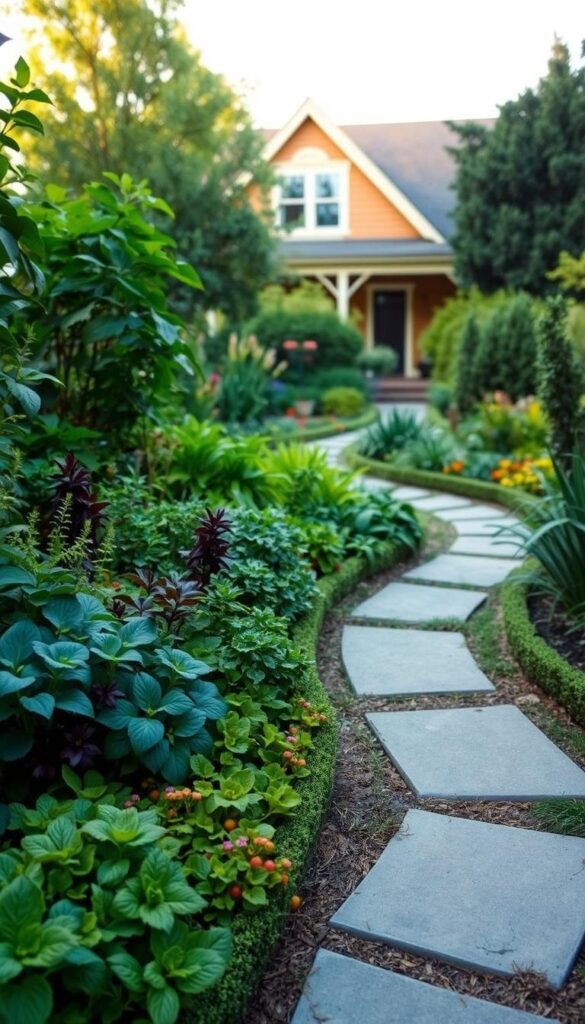
Your home’s exterior becomes both a feast for the eyes and the table when you mix edible and ornamental elements. This approach transforms underused areas into vibrant, productive spaces that deliver multiple rewards beyond typical landscaping.
Enhancing Your Home’s Curb Appeal
Studies show properties with attractive edible landscaping can increase value by up to 20%. Unlike traditional flower beds, food-bearing plants like rainbow chard or purple basil add dynamic color changes through seasons. Their textures create visual depth that keeps your outdoor space interesting year-round.
Enjoying Fresh Produce at Your Doorstep
Imagine snipping herbs for dinner while checking your mail. Having food sources near entryways makes harvesting effortless. Research reveals people maintain gardens better when they’re visible daily. You’ll also save money—a single tomato plant can yield 10-15 pounds of fruit!
These living displays spark conversations with neighbors about sustainability. Many find joy in watching their meals grow from seedling to harvest, creating daily moments of pride. Best part? You control what goes into your soil and onto your plate.
Designing Your Front Yard Vegetable Garden
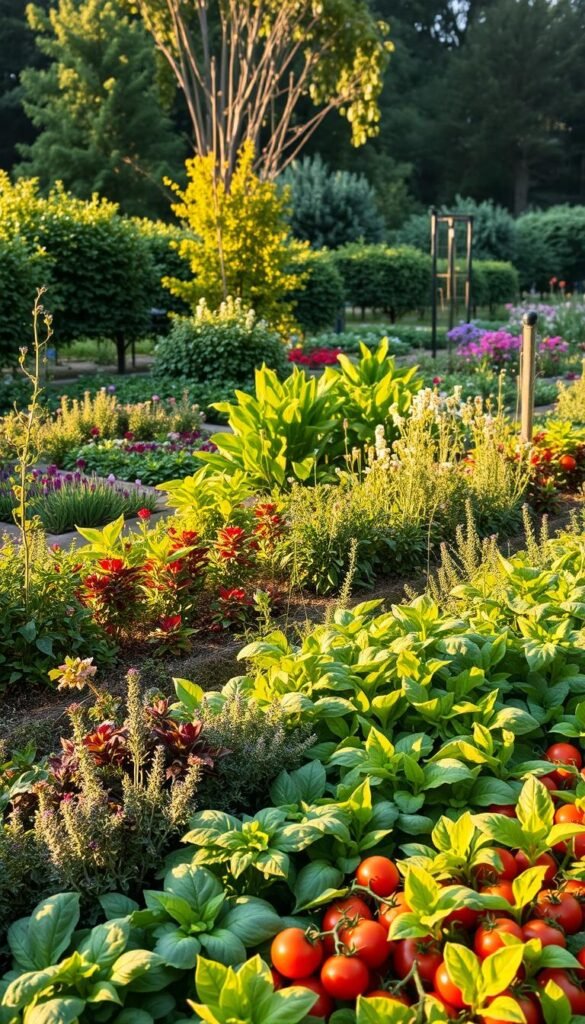
Crafting a welcoming entrance that doubles as a food source starts with smart design choices. Treat edible plants like living decor—position them where they’ll shine alongside blooms and shrubs. This approach transforms your yard into a space that’s both useful and eye-catching.
Integrating Edibles with Ornamental Elements
Pair bold veggies with showy flowers for instant visual harmony. Rainbow chard’s neon stems pop against purple salvias, while curly kale adds texture beside feathery ornamental grasses. Herbs like rosemary or thyme make fragrant borders that soften walkways.
Think about seasonal shifts. Swiss chard’s ruby stalks glow in fall, while blueberry bushes offer fiery foliage. Mix heights for drama—train pole beans up trellises behind low-growing nasturtiums. Every layer should feel intentional, not accidental.
Establishing a Cohesive Garden Layout
Map your space like a pro. Start with a focal point—a sculptural artichoke plant or dwarf fruit tree. Use pathways to guide the eye, framing beds with stone or repurposed bricks. Repeat colors and shapes across your landscape to unify the look.
Group plants with similar needs together. Basil thrives near sun-loving zinnias, while shade-tolerant mint pairs with hostas. This strategic placement simplifies care and boosts growth. Your front yard garden becomes a living masterpiece that evolves with the seasons.
Front Yard Vegetable Garden Ideas: Blend Edibles into Your Curb Appeal
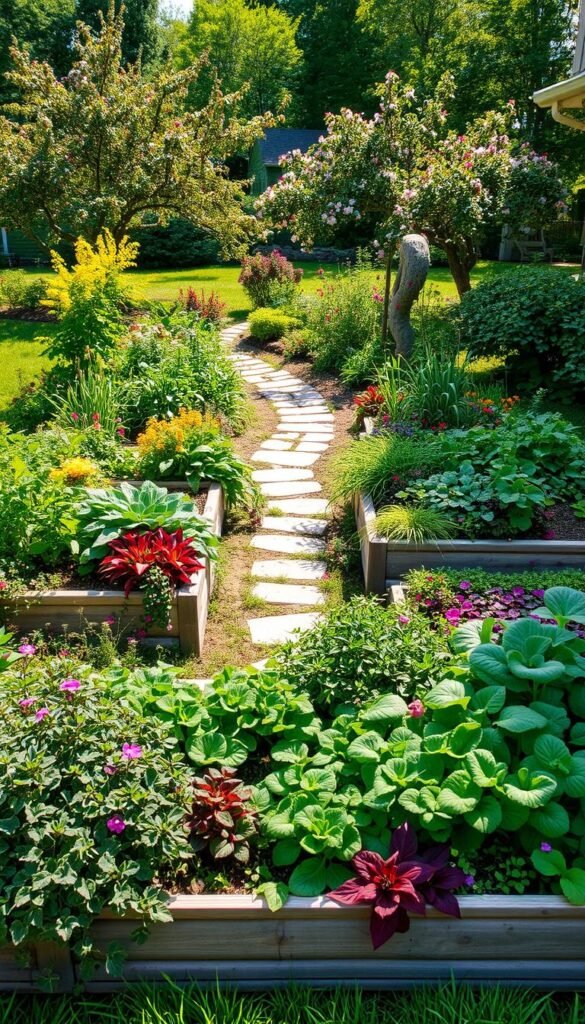
Your outdoor space can dazzle in every season with smart planning. Focus on plants that evolve beautifully through spring blooms, summer bounty, and autumn hues. This approach keeps your landscape vibrant while delivering fresh flavors.
Highlighting Multi-Seasonal Beauty
Start with spring stars like purple sprouting broccoli—its yellow flowers attract pollinators. As summer heats up, transition to colorful peppers and cherry tomatoes that ripen alongside zinnias. Come fall, scarlet runner beans and blueberry bushes put on a fiery show.
Try these strategies for non-stop appeal:
- Layer plants with staggered maturity times
- Swap spent crops with quick-growing varieties like radishes
- Use evergreen rosemary or sage for winter structure
Many gardeners find success with seasonal rotation techniques that maintain both productivity and charm. Pair golden marigolds with eggplant in July, then replace them with ornamental cabbage when frost arrives.
Remember: edible doesn’t mean temporary. Artichokes offer silvery foliage year-round, while dwarf fruit trees provide spring blossoms and fall harvests. Your space becomes a living calendar that celebrates nature’s rhythms.
Choosing the Right Edible and Ornamental Plants
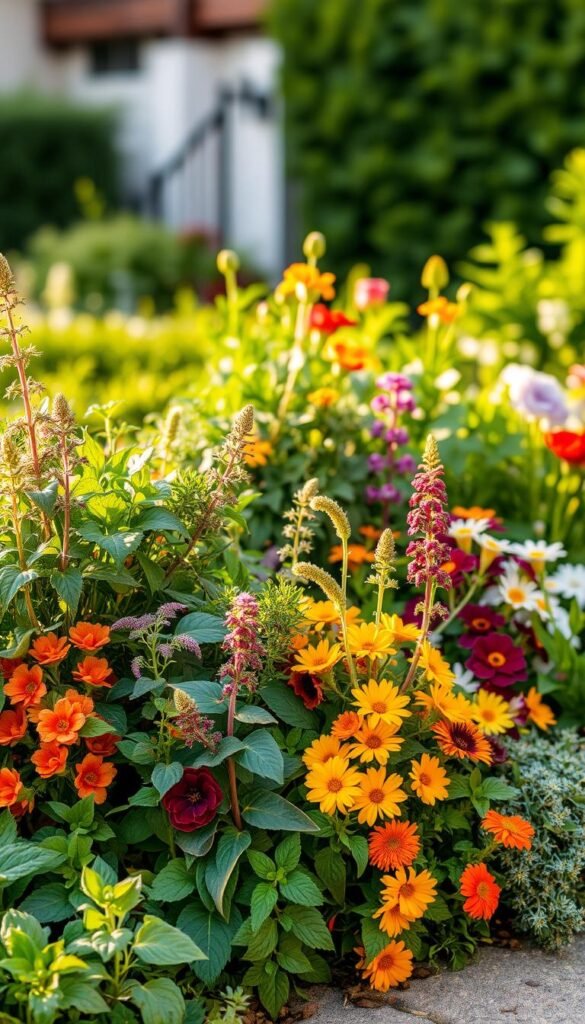
Transform your landscape into a living masterpiece by selecting plants that dazzle the eye and stock your kitchen. Ivette Soler’s design philosophy proves food-bearing varieties can rival traditional ornamentals when chosen strategically. “Every plant must earn its place through beauty and purpose,” she advises in her essential guide.
Prioritizing Plant Form, Texture, and Color
Soler’s four rules simplify decision-making. First, choose specimens with appealing shapes—think basil’s rounded mounds or artichoke’s architectural spikes. Second, pick plants offering multiple visual benefits like Swiss chard’s rainbow stems and crinkled leaves. Third, ensure foliage stays vibrant through summer’s heat. Fourth, balance showstoppers with subtle supports like stone pathways.
| Plant | Color Feature | Texture | Uses |
|---|---|---|---|
| Purple Basil | Deep violet leaves | Glossy surface | Pesto, borders |
| Bull’s Blood Beet | Burgundy foliage | Crinkled edges | Salads, contrast plant |
| Lemon Thyme | Golden-green leaves | Fine, trailing | Seasoning, groundcover |
| Ornamental Pepper | Fiery red fruit | Shiny clusters | Hot sauces, focal points |
Herbs like rosemary pull triple duty—fragrant flowers, evergreen leaves, and culinary versatility. For fruit-bearing stars, consider blueberries. Their spring blossoms become summer snacks and autumn’s crimson foliage. Pair them with lavender for a sensory feast that pleases pollinators too.
Remember: edible landscapes thrive on intentional pairings. Mix feathery dill with bold kale leaves, or let scarlet runner beans climb through flowering shrubs. Your space becomes both pantry and paradise.
Incorporating Hardscape Features and Raised Beds
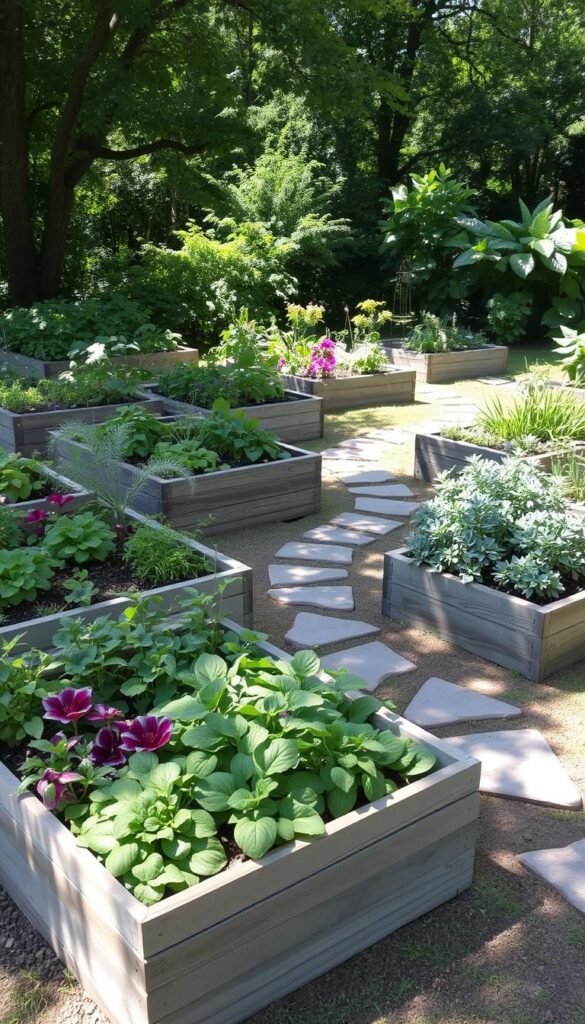
Elevate your outdoor space with raised beds that marry form and function. These structured planters keep your growing areas organized while adding architectural interest. Garden Gate experts praise limestone beds measuring 11×5 ft. or 20×5 ft. for their durability and timeless appeal.
Utilizing Raised Beds for Easy Maintenance
Raised beds simplify gardening through smart design. Their elevated height reduces bending, while contained soil prevents weeds from invading. You’ll control drainage and nutrient levels better than in ground plots. Choose materials that complement your home’s style:
| Material | Lifespan | Best For | Cost |
|---|---|---|---|
| Limestone | 25+ years | Traditional homes | $$$ |
| Cedar | 10-15 years | Rustic designs | $$ |
| Composite | 20+ years | Modern spaces | $$$ |
| Recycled Brick | 15-20 years | Cottage gardens | $$ |
Position beds near pathways for easy harvesting. Leave 18-24″ between planters for comfortable movement. This layout creates clean lines that neighbors will admire.
Creating Decorative Borders for a Polished Look
Define your garden plans with borders that whisper sophistication. Metal edging adds sleek contrast to lush greens, while stacked stone creates natural transitions. Try these pro tips:
Edge beds with dwarf boxwood for year-round structure. Use crushed granite paths to connect planting zones. Add a bench surrounded by fragrant herbs—it becomes both a seating area and scent garden.
Remember: great design balances beauty and purpose. Your raised beds become sculptural elements, while borders frame the space like living artwork. Together, they transform practical growing areas into neighborhood showpieces.
Seasonal Planting Tips and Garden Maintenance
Keep your outdoor space thriving through changing seasons with smart scheduling and care routines. A well-maintained edible landscape stays productive while keeping its visual charm, even during temperature swings.
Adapting Plant Choices to Spring and Fall
Rotate crops based on weather patterns. Start cool-season veggies like spinach in early spring, then switch to heat-loving peppers when soil warms. In fall, plant quick-growing radishes or ornamental kale before frost hits.
Try these rotation pairs:
- Spring peas → Summer beans → Fall garlic
- Lettuce → Basil → Swiss chard
Maintaining Plant Health with Regular Care
Check leaves weekly for pests like cabbage worms. Remove yellow foliage promptly to prevent disease spread. Water deeply 2-3 times weekly—use a rain gauge to track 1½” total from showers or irrigation.
Boost defenses naturally:
- Spray spinosad on beetle-prone areas at dusk
- Plant marigolds near tomatoes to deter nematodes
- Mulch with straw to retain moisture
Time harvests to encourage new growth. Pick zucchini when 6-8″ long, and snip herbs before they flower. Your efforts pay off in vibrant plants and endless salads!
Navigating HOA and Neighborhood Guidelines
Growing food where everyone can see it requires balancing productivity with community standards. Many neighborhoods allow edible plants when they enhance curb appeal rather than disrupt it. The secret? Treat your tomato vines like roses and your kale like decorative shrubs.
Smart Strategies for Seamless Integration
Start by reviewing your home’s governing documents. Most HOAs permit edible plants if they follow lawn coverage rules—typically 70% traditional landscaping. Mix food crops with approved ornamentals in flower beds. For example, pair red lettuce with petunias or tuck peppers between hydrangeas.
Try these neighbor-friendly techniques:
- Use decorative containers for herbs near entryways
- Train beans up ornamental trellises instead of plain stakes
- Edge pathways with strawberry plants instead of ivy
Remember, property values often depend on neighbors’ perceptions. Choose plants that look intentional year-round. Dwarf fruit trees offer spring blossoms, while purple cabbage adds winter color. Your yard becomes a conversation starter, not a controversy.
Need more space? Convert part of your backyard into a hidden veggie patch while keeping the front lot picture-perfect. With thoughtful planning, you’ll harvest basil and compliments in equal measure.
Wrapping Up Your Beautiful Front Yard Vegetable Garden
Your outdoor space now holds dual potential—a feast for the senses and the table. By merging food-growing areas with artistic design, you’ve created a living tapestry that nourishes both body and soul. This approach turns everyday meals into celebrations of your hard work.
Remember these essentials: choose plants that dazzle in form and flavor, pair them with strategic hardscaping, and maintain seasonal rhythms. Raised beds keep crops organized, while flowering companions like lavender add pollinator appeal. Your landscape becomes a classroom teaching neighbors about eco-friendly living.
The rewards multiply over time. You’ll snack on sun-warmed berries while watching property values rise. Shared harvests build community bonds, turning casual observers into fellow growers. Every ripe tomato or crisp carrot becomes living proof that beauty and practicality thrive together.
With this knowledge, your edible paradise will evolve gracefully. Experiment with new plant pairings, expand productive zones, and savor each season’s unique gifts. Your home now wears its values proudly—a delicious invitation to rethink what landscapes can achieve.
